15 Smallest African Antelopes: Species, Range, Size, Photos (Full Guide)
Curious about small antelopes? In this article, you will learn about the different features of the 15 smallest African antelopes. We’ll also discuss their size, weight, habitat, and range. Plus lots of photos. Two species weigh less than 7 pounds each!
Smallest African Antelope: By Weight
Here is a summary of the smallest antelopes in Africa, by weight. See full details and photos below.
- Royal Antelope: 6 lbs (2.7 kg)
- Bate’s Pygmy Antelope: 6.6 lbs (3 kg)
- Günther’s Dik-Dik: 10 lbs (4.5 kg)
- Blue Duiker: 11 lbs (5 kg)
- Suni: 11 lbs (5 kg)
- Kirk’s Dik-Dik: 16 lbs (7.2 kgs)
- Sharpe’s Grysbok: 21 lbs (9.5 kg)
- Cape Grysbok: 22 lbs (10 kg)
- Steenbok: 26 lbs (12 kgs)
- Klipspringer: 28 lbs (12.7 kg)
- Red Duiker: 31 lbs (14 kg)
- Oribi: 31 lbs (14 kg)
- Grey Duiker: 35 lbs (16 kg)
- Mountain Reedbuck: 66 lbs (30 kgs)
- Yellow-Backed Duiker: 137 lbs (62 kg)
Guide to the 15 Smallest African Antelopes
Let’s look at the 15 smallest, and arguably the cutest, antelopes in Africa. They are ordered from smallest (lightest) to heaviest.
For common questions about antelopes, jump to the end of the post.
1. Royal Antelope
- Common Name: Royal Antelope
- Latin Name: Neotragus Pygmaeus
- Habitat: The lowland forests of Guinea, Ghana, Liberia, Sierra Leone, and Côte d’Ivoire
- Weight: 5.5-6.5 pounds (2.5-3 kilograms)
- Height: 10 inches (25 centimeters) at the shoulder
The Royal Antelope is the smallest Antelope in the world, weighing less than your average house cat. It’s also the smallest ruminant in the world. It’s known for its slender legs. Its hind legs are twice as long as its front legs. This gives it extreme jumping ability.
In fact, a Royal Antelope can cover 9.2 feet (2.8 meters) in a single leap, and bounce as high as 22 inches (55 centimeters) above the ground.
The Royal Antelope is a nocturnal creature. It can be found either resting or ruminating during the day, and foraging at night. They are not herd animals, but rather live by themselves or with a mate. They are usually monogamous.
An interesting fact about Royal Antelopes is the size of their young. At birth, the single newborn will weigh between 1.8 and 2.2 pounds (0.8-1 kilogram). This is nearly a third of the weight of the mother. By comparison, it would be like a 150 pound (68 kilograms) human woman giving birth to a 50 pound (22.7 kilograms) baby. Ouch.
2. Bate’s Pygmy Antelope
- Common Name: Bate’s Pygmy Antelope, Dwarf Antelope, Pygmy Antelope, Bate’s Dwarf Antelope
- Latin Name: Nesotragus Batesi
- Habitat: Humid lowland forests in Tropical Central Africa
- Weight: 4.4-6.6 pounds (2-3 kilograms)
- Height: 20-22 inches (50-57 centimeters)
These tiny antelope are a dark chestnut brown that becomes lighter toward the flanks. Males will make a nasally call when looking for a female. And both the male and female will make a short raspy bark when scared.
They are usually not hunted for meat. However, because humans have infringed on their territory, Pygmy Antelopes have been known to nibble on farmers crops, including peanuts. So some farmers will set snares and traps.my
3. Günther’s Dik-Dik
- Common Name: Günther’s Dik-Dik, Guenther’s Dik-Dik
- Latin Name: Madoqua Guentheri
- Habitat: Thickets, Savannah, and Woodlands in Ethiopia, Kenya, Somalia, Sudan, and Uganda
- Weight: 6.5-11 pounds (3-5 kilograms)
- Height: 12 inches (30 centimeters)
Günther’s Dik-Diks have long snouts, small heads, big ears, and a tuft of long hair that grows between their horns.
Like the Kirk’s Dik-Dik, their unique snouts help them to thermoregulate and reduce the amount of moisture lost from their bodies. This helps them to be able to stay in the same small territory without having to go out in search of water. So if a predator were to show up, the Dik-Dik has the advantage of knowing the terrain and available hiding spots.
They may be little, but they don’t let that stop them in terms of diet. They like leaves but aren’t tall enough to reach them on their own. So they hang around elephant and giraffe feeding areas, waiting for a branch to be dropped to the ground.
4. Blue Duiker
- Common Name: Blue Duiker
- Latin Name: Philantomba Monticola
- Habitat: Heavily wooded areas in Central, Southern, and Eastern Africa
- Weight: 7.7-19.8 pounds (3.5-9 kilograms)
- Height: 13-16 inches (32-41 centimeters) at the shoulder
Of the 22 types of Duiker Antelopes, the Blue Duiker is the smallest. The females are slightly larger than the males. Unlike the Royal Antelopes which are nocturnal, the Blue Duikers are diurnal. This means that they are active in the daytime.
A cool feature of the Blue Duiker is its tail. It has a row of crinkly white hairs on either side that reflect light very efficiently. So when it moves its tail up and down in the dimly lit forest, it looks like it’s sending out a luminous signal.
Blue Duikers are very vocal and make many different sounds. If it’s in a curious mood, you may hear bird-like chirping. If distressed, it will let out a yowl similar to a cat. And a female trying to avoid a male’s advances may let out a whistling call.
5. Suni
- Common Name: Suni
- Latin Name: Nesotragus Moschatus
- Habitat: In dense underbrush from central Kenya to South Africa
- Weight: 9-12 pounds (4.5-5.4 kilograms)
- Height: 12-17 inches (30 to 43 centimeters) at the shoulder
These shy antelope are mostly active at night. Sunis eat leaves, fruits, flowers, and fungi. Their predators include lions, snakes, and birds of prey. Their reddish-brown fur and light underbellies help keep them camouflaged.
6. Kirk’s Dik-Dik
- Common Name: Kirk’s Dik-Dik (Subspecies include Damara dik-dik and Cavendish’s dik-dik)
- Latin Name: Madoqua Kirkii
- Habitat: Savannah areas in Eastern and parts of Southwestern Africa
- Weight: 16 pounds (7.2 kilograms)
- Height: 14-18 inches (35.5-45.7 centimeters)
There are so many neat and unique things that can be said about the Damara Dik-Dik. Firstly, let’s consider their name. The name Dik-Dik is onomatopoeic, meaning that it sounds like a noise. When a Dik-Dik is scared it makes a wheezing noise that sounds a bit like “Dik-Dik.”
Another neat thing about the Damara Dik-Dik is its nose. Because it lives where the temperature can reach up to 104°F or 40°C, the Dik-Dik needs a way to stay cool. This is where its nose comes in handy. When it gets hot, its nose functions like a bellow bringing air in and out. Evaporation which occurs in the nose cools the surrounding blood vessels, which in turn, circulate cooled blood around the body.
While territorial disputes are rare, they are pretty non-violent when they occur. The males will charge at each other, but stop short of actually running into one another. They will continue to do this until one of them gets tired and walks away. The territory boundaries are marked by a males dung. He will even defecate directly on top of the female’s dung to mark what is his.
Their mating ritual is also interesting. It starts with the male running behind the female with his head and neck outstretched. “Copulation begins with the male standing on his hind legs behind the female and waving his forelegs at an acute angle to his own body in the air over her back.” Source: Animal Diversity
7. Sharpe’s Grysbok
- Common Name: Sharpe’s Grysbok or Northern Grysbok
- Latin Name: Raphicerus Sharpei
- Habitat: Rocky hills and Fertile Slopes in South-Eastern Africa
- Weight: 15.4-25.4 pounds (7-11.5 kilograms)
- Height: 17.7-23.6 inches (45-60 centimeters) at the shoulders
The Sharpe’s Grysbok has a stocky body, short neck, and long legs. From the description, you would think that it is a funny-looking animal, but it’s actually adorable.
When they get nervous, they make a few short, stomping hops before running away. Because they are so timid they can be hard to find. But you may see one hiding in an aardvark burrow.
8. Cape Grysbok
- Common Name: Cape Grysbok or Southern Grysbok
- Latin Name: Raphicerus melanotis
- Habitat: Thick shrubland in the Western Cape area of South Africa, between the Cederberg and Albany mountains.
- Weight: 17.5-26.5 pounds (8-12 kilograms)
- Height: 17.7-21.7 inches (45-55 centimeters) at the shoulder
The Cape Grysbok is a sandy reddish color with white flecks. Although small in size, this antelope can fluff up its fur to make itself look bigger.
It’s similar in many ways to the Sharpe’s Grysbok. The main difference in physical appearance is that the Sharpe’s Grysbok has a pair of “false hooves” above the fetlocks (a fetlock is similar to an ankle), while the Cape Grysbok does not.
9. Steenbok
- Common Name: Steenbok, Steinbuck, Steenbuck, or Steinbok
- Latin Name: Raphicerus Campestris
- Habitat: A wide variety of habitats in Eastern and Southern Africa
- Weight: 26 pounds (12 kilograms)
- Height: 16-24 inches (45-60 centimeters) at the shoulder
The Steenbok is very common in Southern and Eastern Africa. They live in varied habitats such as semi-arid areas bordering on desert, as well as bush and grassland.
They have large ears, which are great for hearing the sounds of approaching predators, of which they have many. They are hunted by big cats, jackals, wild dogs, pythons, large eagles, and humans.
When scared, their first response is to freeze like a statue, hoping not to be seen. If that’s not successful, they’ll run away in a zig-zag pattern, periodically looking back to see if they are in the clear.
A cool thing about the Steenbok is that they are the only antelope that have “etiquette” when using the washroom. They will first dig a hole in which they urinate or defecate. When they are finished, they cover over the hole.
There are two good reasons why they do this. The first is that it makes it harder for predators to track them, because they leave no visual droppings on the surface. The second is that the scent they leave gets trapped for longer, making it easier to mark their territory. Steenbok’s like to live alone, and only come together to mate.
10. Klipspringer
- Common Name: Klipspringer
- Latin Name: Oreotragus Oreotragus
- Habitat: Rocky Terrains throughout Southern and Eastern Africa
- Weight: 18-40 pounds (8-18 kilograms)
- Height: 17-23 inches (43-60 centimeters) at the shoulder
The Klipspringer has thick, course hair and hollow brittle horns. Unlike a lot of the other antelopes that prefer to live solitary lives (unless it’s mating season), the male and female Klipspringer like to stick together.
They tend to stick within 16 feet (5 meters) of each other and stay with the same partner long-term, even forming lifelong bonds.
They like to live in rocky areas with sparse vegetation. The inaccessibility of their habitat serves as a protection from hunters.
Klipspringers tend to walk on their tippy-toes or “tippy-hooves.” This helps them to get more grip in their rocky mountain home when climbing and jumping around.
11. Red Duiker
- Common Name: Red Forest Duiker, Natal Duiker, or Natal Red Duiker
- Latin Name: Cephalophus Natalensis
- Habitat: Forests and Dense Bush areas in South-East Africa
- Weight: 30.9 pounds (14 kilograms)
- Height: 17 inches (43 centimeters) at the shoulder
Very similar to the Grey or Common Duiker, the Red Duiker is smaller in size and distinguished by its reddish coloring. Its habitat is also different, as it favors the denser bush as opposed to the open savannah. Like the Royal Antelope, they have longer back legs, perfect for jumping.
Duikers are very territorial. They have special scent glands on their faces near their eyes. To mark their territory they will rub their faces on surfaces like bark, grass, and twigs. Sometimes the male Red Duiker will even scent mark its mate or offspring!
Duiker is the Dutch word for Diver, because when this antelope is startled it dives into the bushes and out of sight.
Origin of Duiker: The Afrikaans word duikerbok, is a combination of two Dutch words: duiker and bok (diving buck.) Many languages have words for animals that don’t exist in their original country of origin.
12. Oribi
- Common Name: Oribi
- Latin Name: Ourebia Ourebi
- Habitat: Savannahs and Grasslands in Countries Across Africa
- Weight: 26-49 pounds (12-22 kilograms)
- Height: 20-26 inches (50-67 centimeters) at the shoulder
Depending on the habitat, Oribi’s may live in one of three mating systems: Polyandry (one female with multiple males), Polygyny (one male and multiple females), or Polygynandry (both male and female have multiple partners).
Interestingly, males with more symmetrical horns will have a greater number of females than those with uneven horns.
13. Grey Duiker
- Common Name: Grey Duiker, Bush Duiker, or Common Duiker
- Latin Name: Sylvicapra Grimmia
- Habitat: Grassy Savannah and Hilly areas, South of the Sahara Desert
- Weight: 26 to 55 pounds (12 to 26 kilograms)
- Height: 20 inches (50 centimeters)
The Grey Duiker has an interesting diet. In addition to the usual leaves, flowers, and fruits, they will also eat frogs, insects, small birds and mammals, and even carrion (decaying flesh of dead animals).
They like hanging out under trees where monkeys are feeding so that they can take advantage of any fruit that may get dropped. As they get most of their liquids from the food they eat, they drink very little water. In fact, they may go through the whole rainy season without taking a drink of water.
14. Mountain Reedbuck
- Common Name: Mountain Reedbuck
- Latin Name: Redunca Fulvorufula
- Habitat: Mountainous areas of Sub-Sahara Africa
- Weight: 66 pounds (30 kilograms)
- Height: 30 inches (75 centimeters) at the shoulder
There are three subspecies of the Mountain Reedbuck. The Southern Mountain Reedbucks inhabit the eastern parts of South Africa and Botswana. Chandler’s Mountain Reedbuck can be found in Tanzania, Kenya, Uganda, Ethiopia, and Sudan.
Then there is the Adamawa Mountain Reedbuck that is found only in Cameroon.
As their name suggests, these antelopes are found at high altitudes in mountain regions. They live in small groups of up to 6 animals, one male and several females and juveniles. Once they’re old enough, adolescent males will get kicked out of the herd. Until they find females of their own, they may join together and form a bachelor herd.
Due to overhunting and humans encroaching on their territory, the Mountain Reedbuck is on the Endangered Species list.
15. Yellow-Backed Duiker
- Common Name: Yellow-Backed Duiker
- Latin Name: Cephalophus Silvicultor
- Habitat: Forested areas throughout Central and Western Africa
- Weight: 132-176 pounds (60-80 kilograms)
- Height: Up to 34 inches (87 centimeters) at the shoulder
The largest of the Duikers, the Yellow-Backed Duikers are known for the orange tuft of hair that grows between its two horns. They also have a yellow patch of hair on their rump. This rump hair will stand raised up if the Duiker feels threatened.
Duikers have no natural defenses and are very skittish. When threatened, they have a habit of running blindly out of fear. If a light is shone in their eyes they will freeze, much like “a deer in headlights.” This makes them easy prey for hunters.
They are a vital source of food and income for humans living close to their habitats. But now Duikers are at risk of overhunting.
What is an Antelope?
There is some debate as to what an antelope actually is, as they are not a taxidermically defined group. Rather, it is a miscellaneous group of mammals under the classification of Bovidae, that are not cows, sheep, or goats.
All antelope have evenly split hooves, and are ruminants (meaning that they chew their cud).
How Many Species of Antelope are There?
Globally, there are 91 species of antelopes.
Where do Antelope Live?
74 of the 91 species of antelope live in Africa. Other types of antelopes live in India, Central Asia, Russia, and the Arabian Peninsula.
There are no true antelope species native to Australia or the Americas. Learn more about all 74 African antelope species.
Are Deer a Type of Antelope?
No, while they look similar, deer and antelope are from different scientific classed families. Antelope are from the Bovidae family, and deer are from the family Cervidae.
Learn about the only African deer.
One difference is that male deer grow antlers that they shed every year. Antelopes grow horns that are permanent.
Learn about the difference between horns and antlers.
Learn more about 16 big African antelope species.
Your Turn:
Have you seen one of these beautiful creatures in real life? What was your favorite small antelope fact? Tell me about your experience in the comments below.

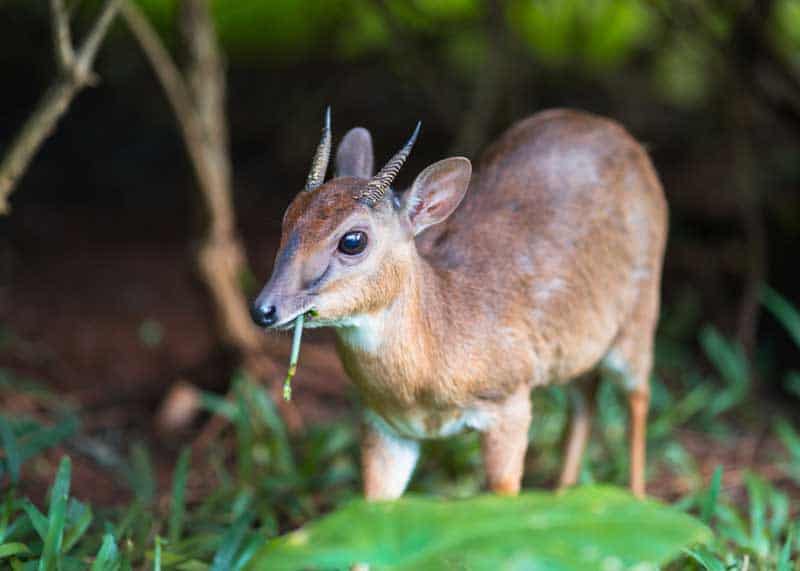
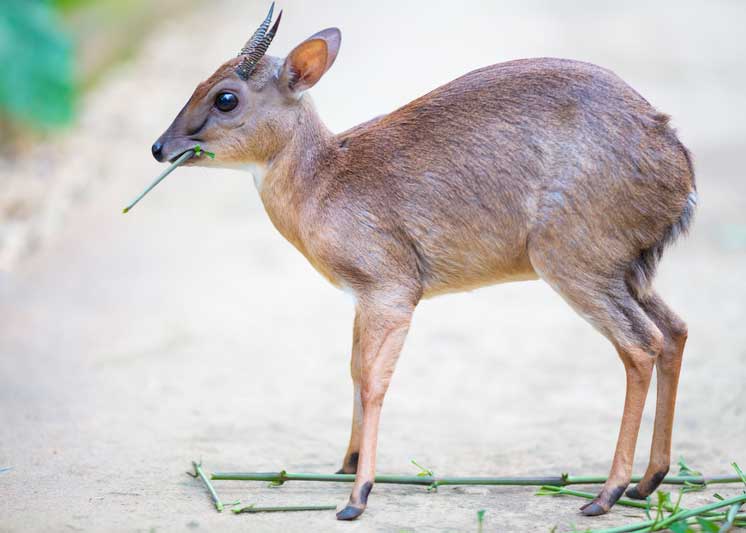
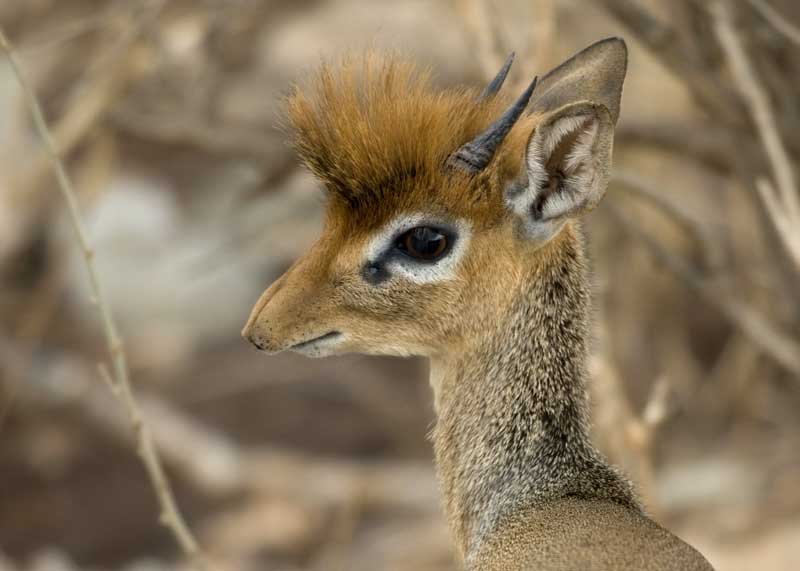
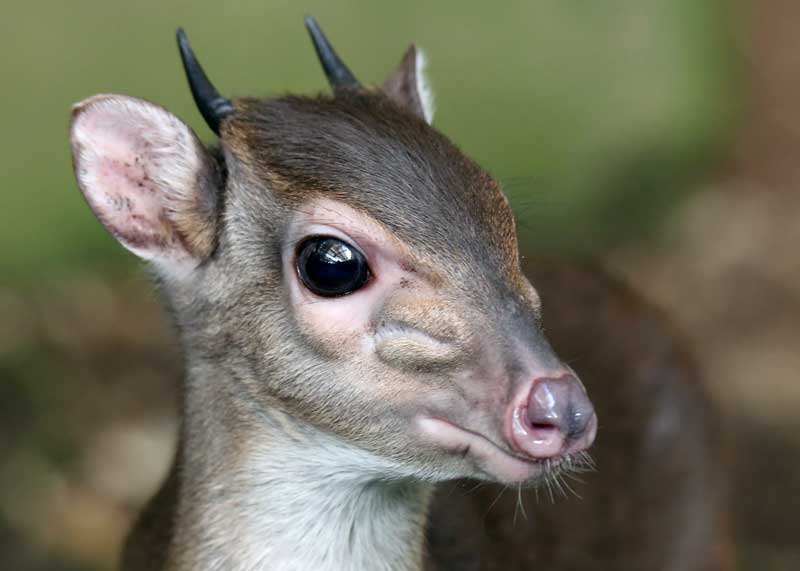
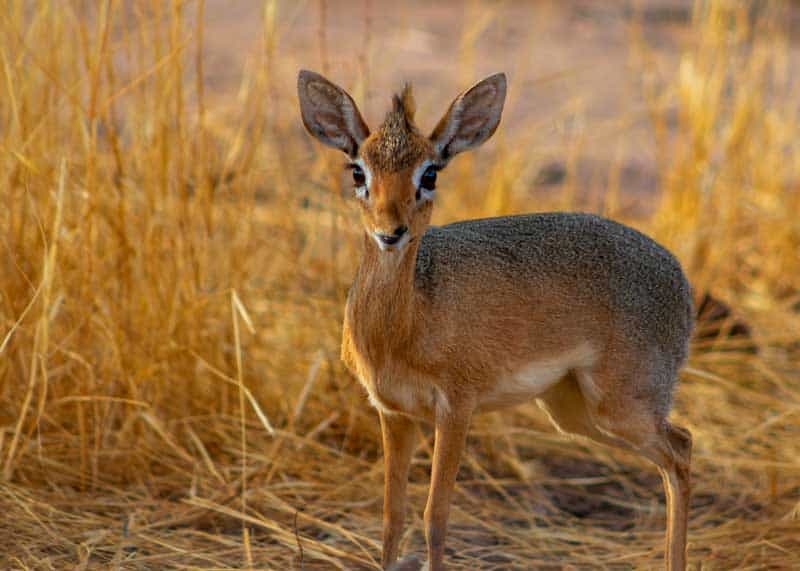
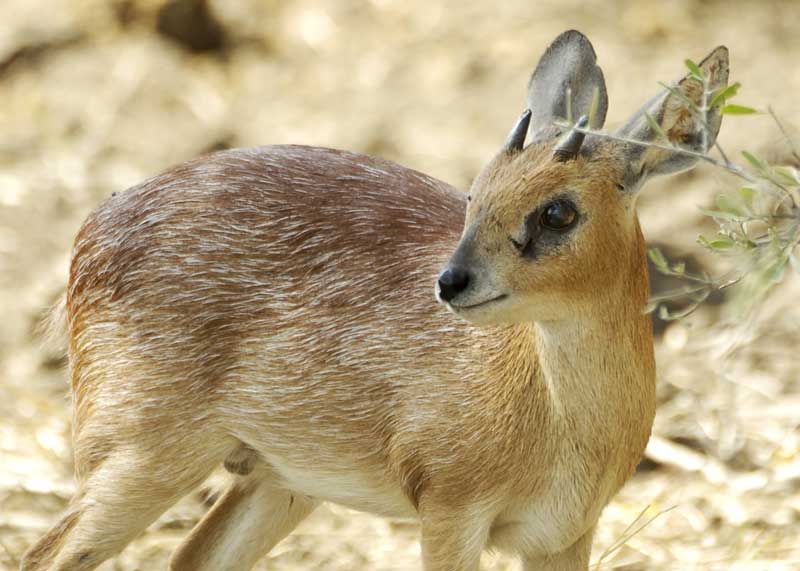
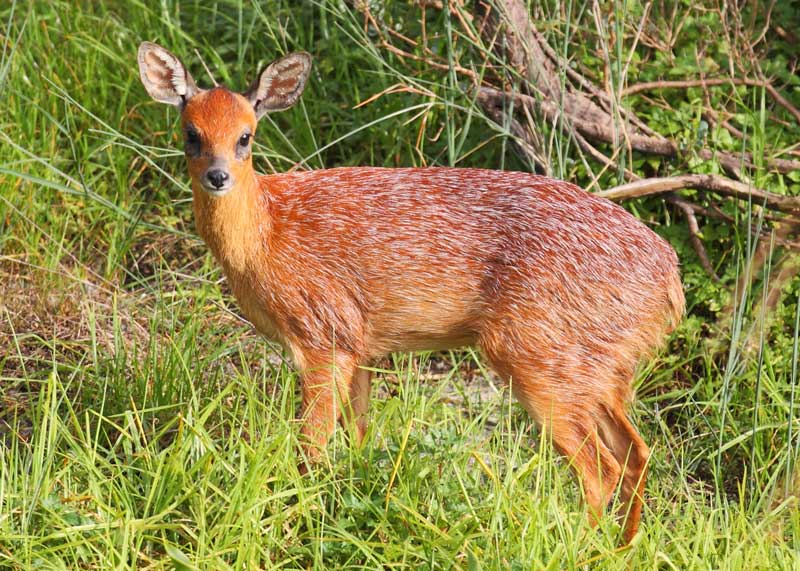
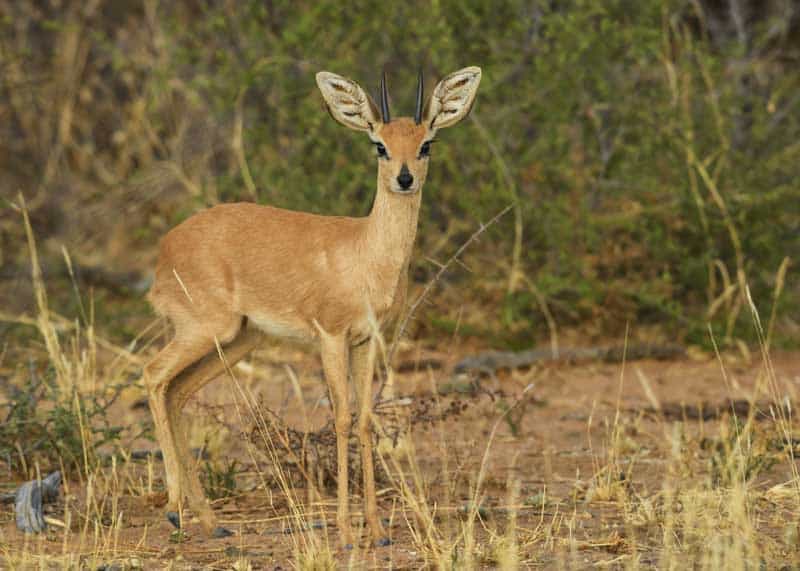
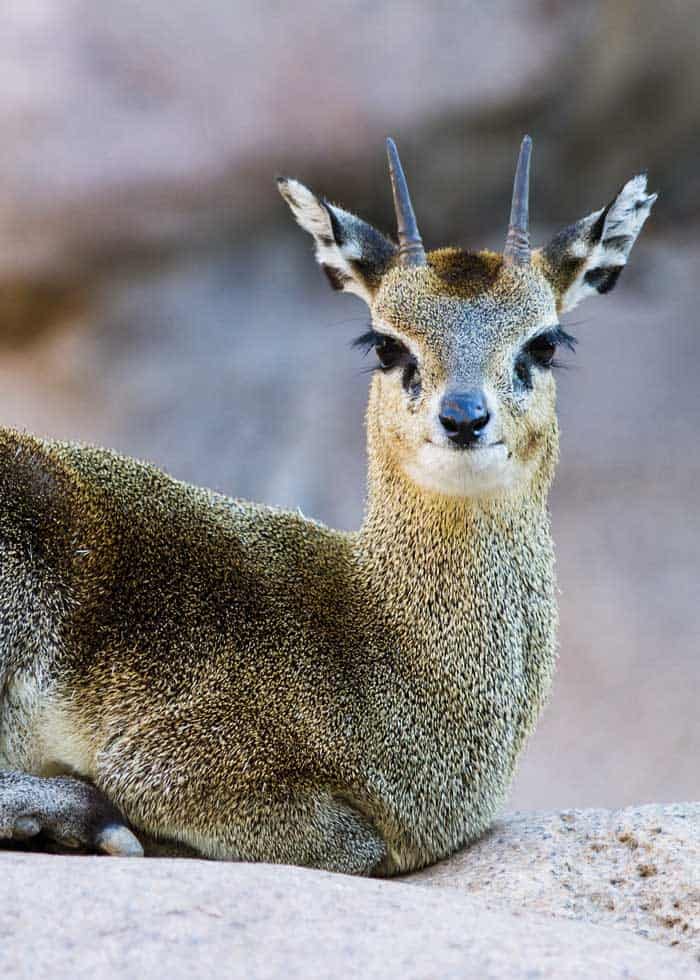
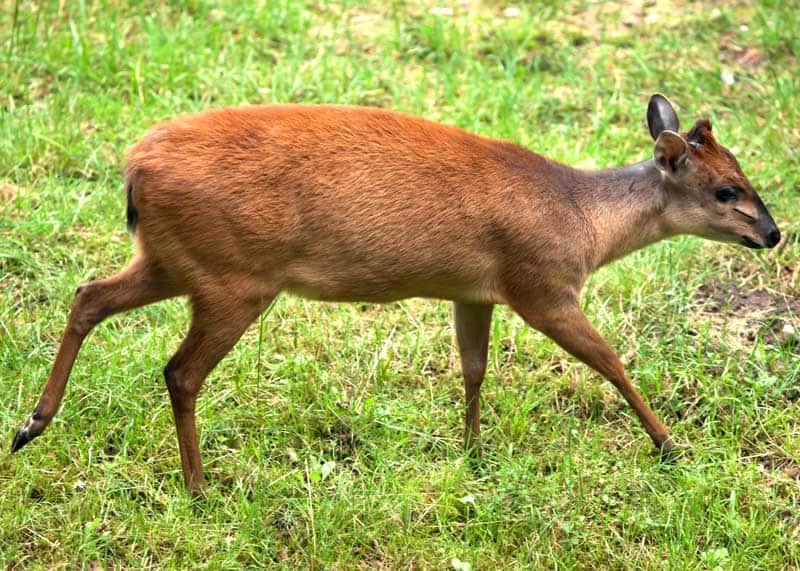
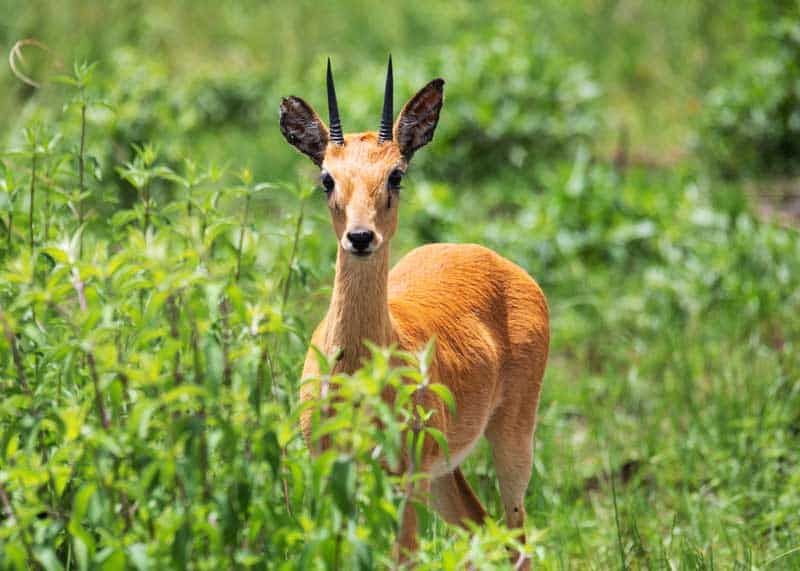
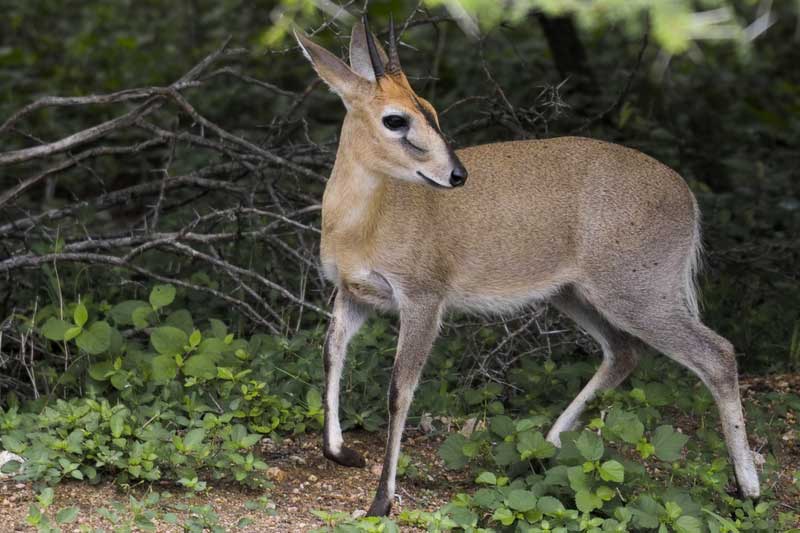
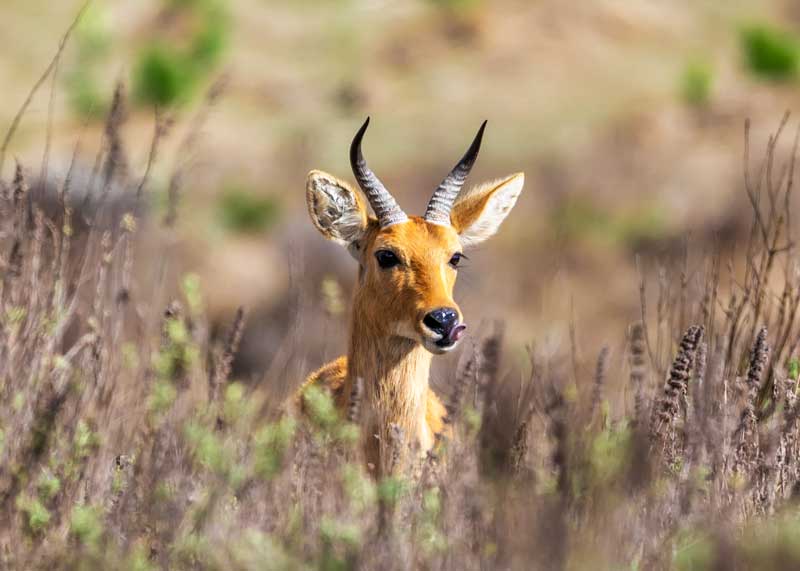
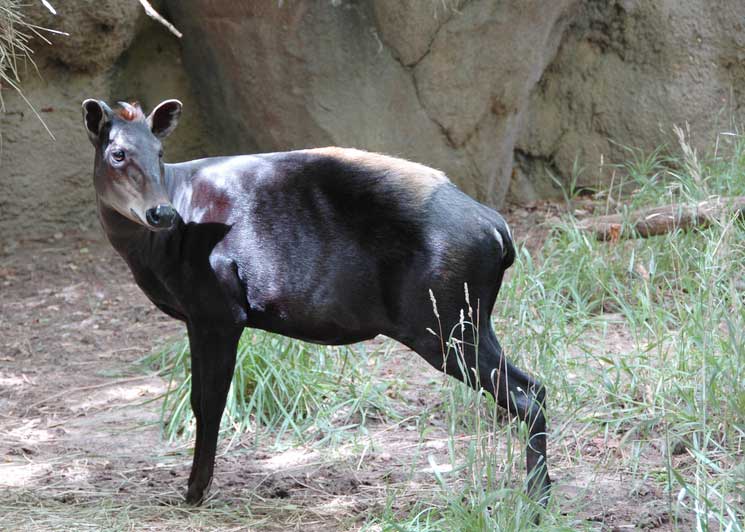
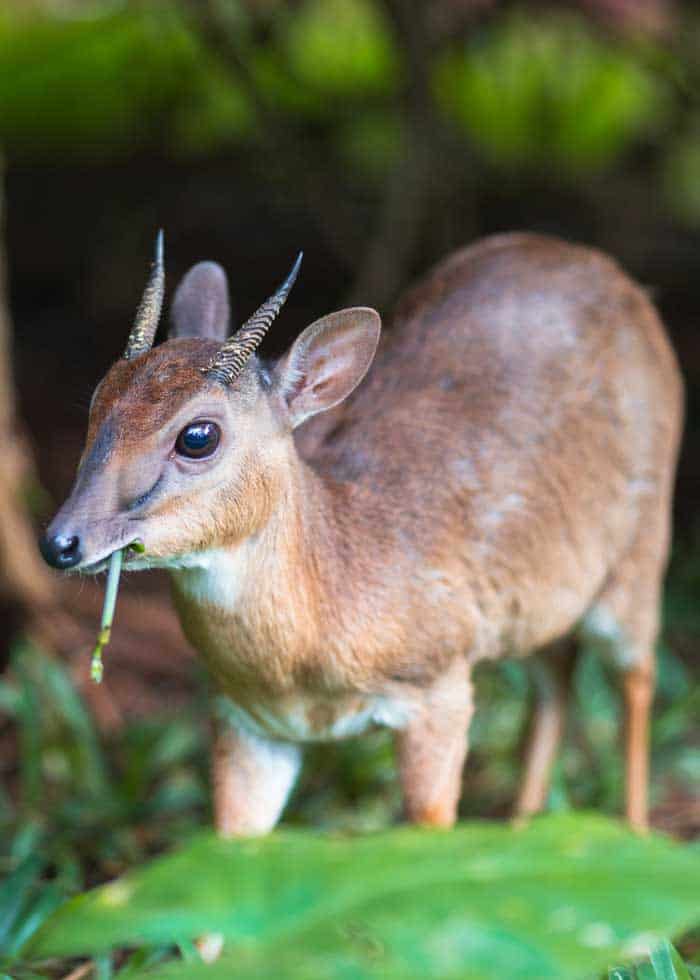





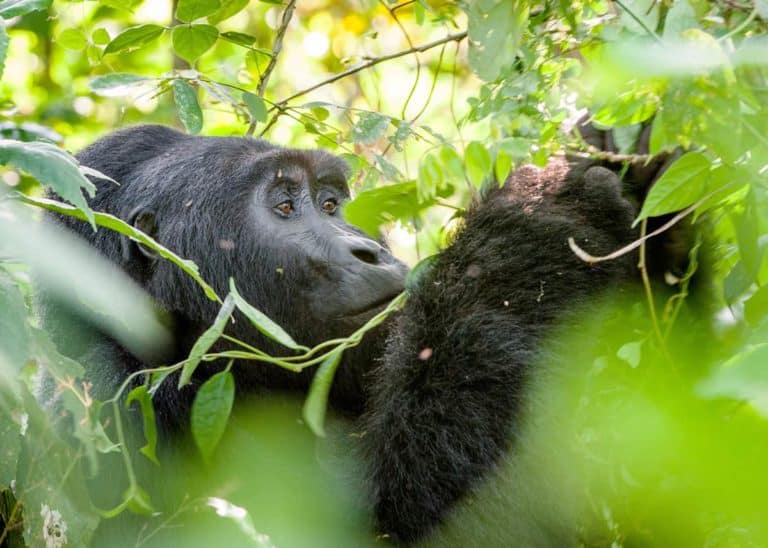
Hi, 12 July, 2022.
I am leary of anyone who has “Ann”
In their name. But I’ll chance it.
My name is Ernie Farrow. I was a Peace Corps volunteer in Tanganyika (1964 – 1967).I lived outside Shinyanga, Kahama, Dadoma, Mpwapwa, Kondoa, Jangalo – doing rural road improvement.
It has been a while and my memory is fading. Dik-dik probably saw more of me than I of them. I loved how fragile and delicate they were. Could not understand how they could survive with all the crunching/grinding going on.
Later I worked on roads in the Selous Game Sanctuary (also doing road improvement) Did not see any smaller small antelope there, unfortunately. Lots of big ones (Eland, Kudu, etc.) Really liked – but was wary of the Matabele ants (Siafu (driver) ants get too much publicity).
May not be what you wanted – but hey?
Ernie. (ernieffarrow@gmail.com)
P.S. Duiker maybe a small antelope but there are many. In Africans it means “diver” for how they dive into the brush.
“Duiker” is the AFRIKAANS word for this animal. Dutch is the language of the Netherlands and there are no duikers there!
Duiker is also the Dutch word for diver, as explained in the post. And because of the traits of these little guys, they have been also called duiker.
In fact, the Afrikaans word duikerbok, is a combination of two Dutch words: duiker and bok (diving buck.) Many languages have words for animals that don’t exist in their original country of origin.